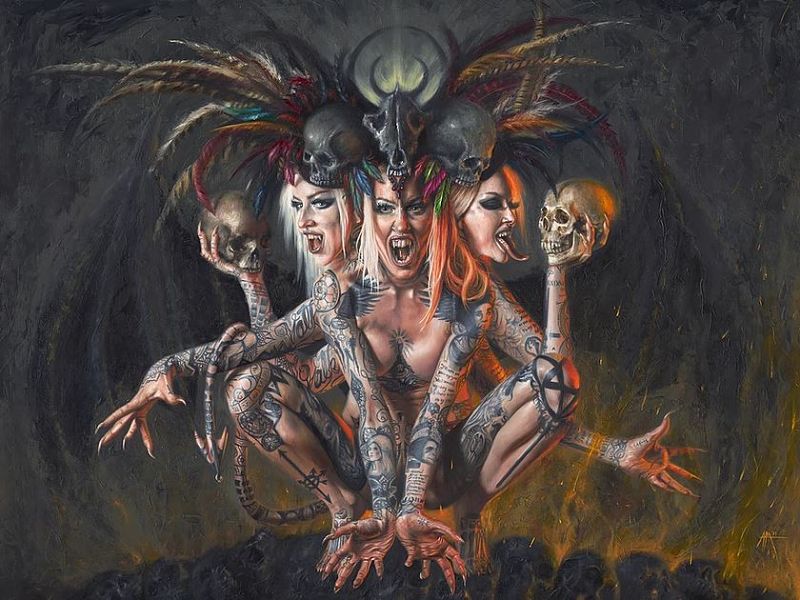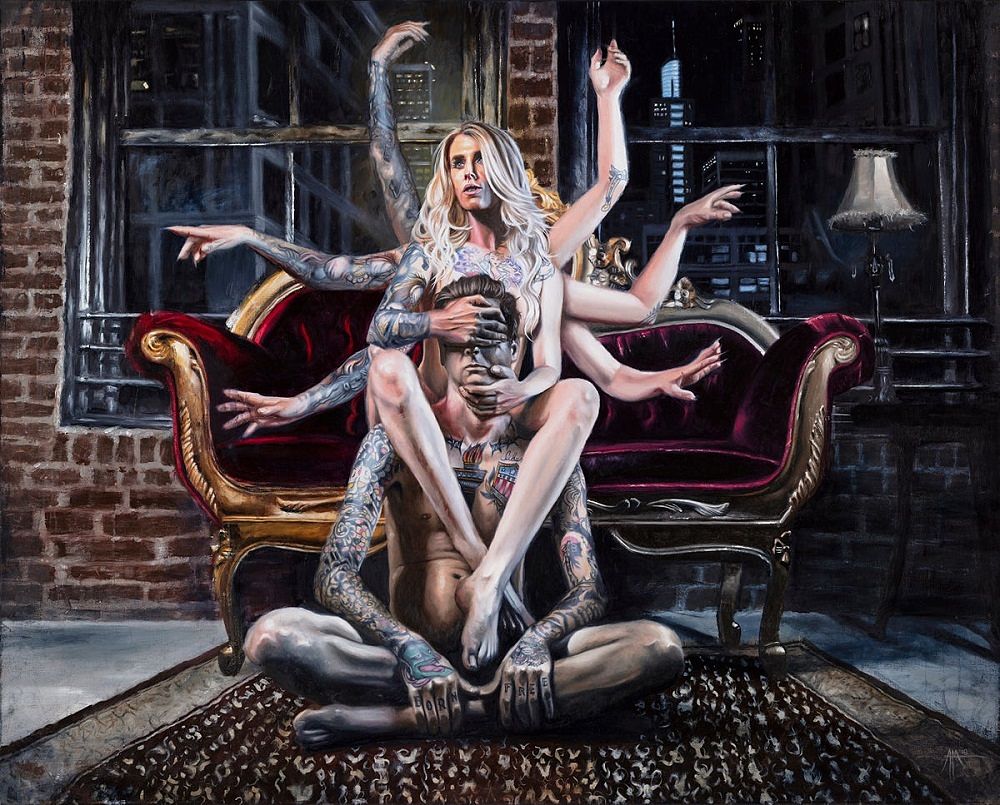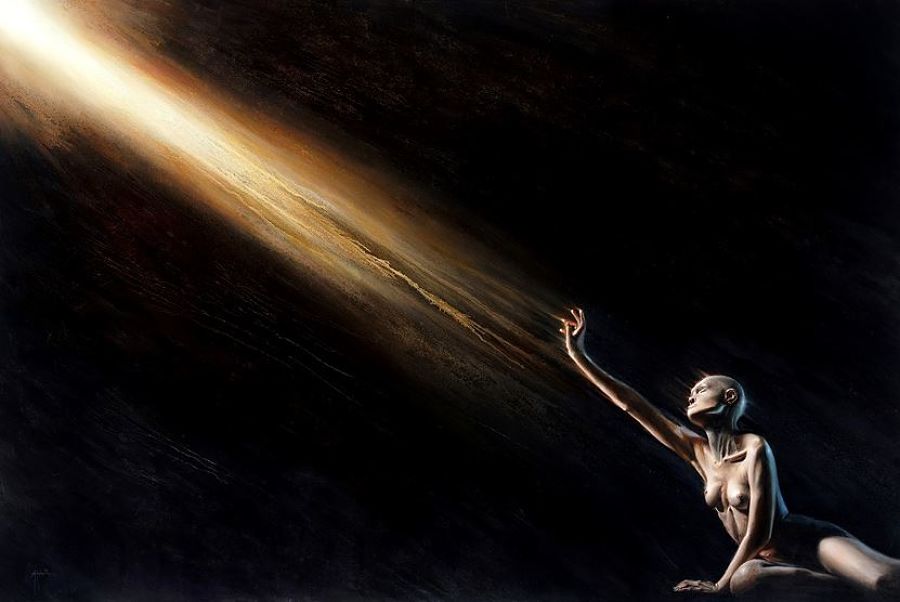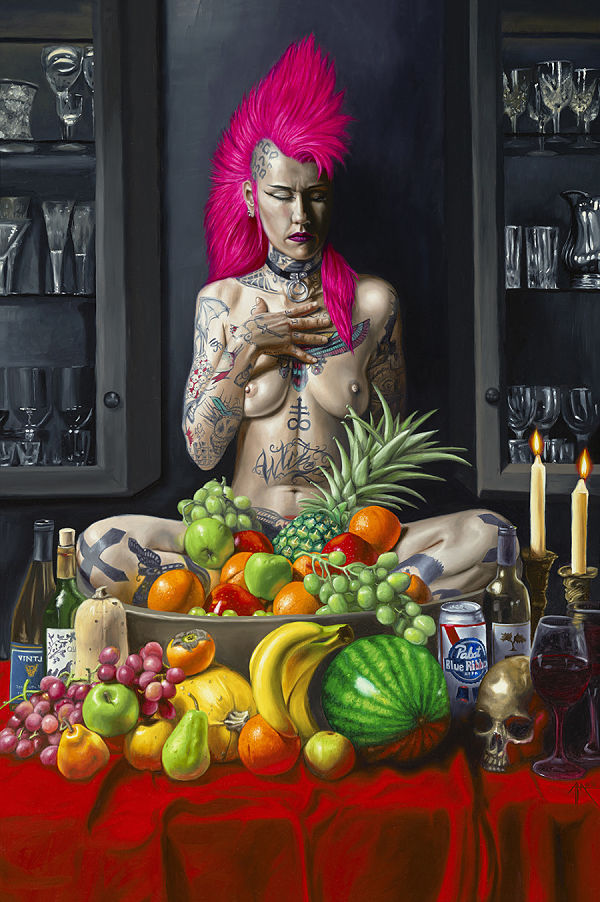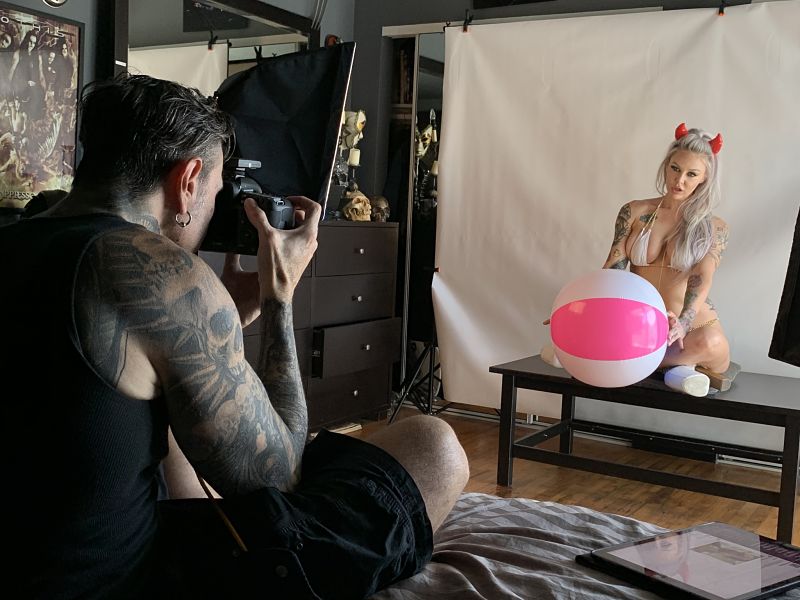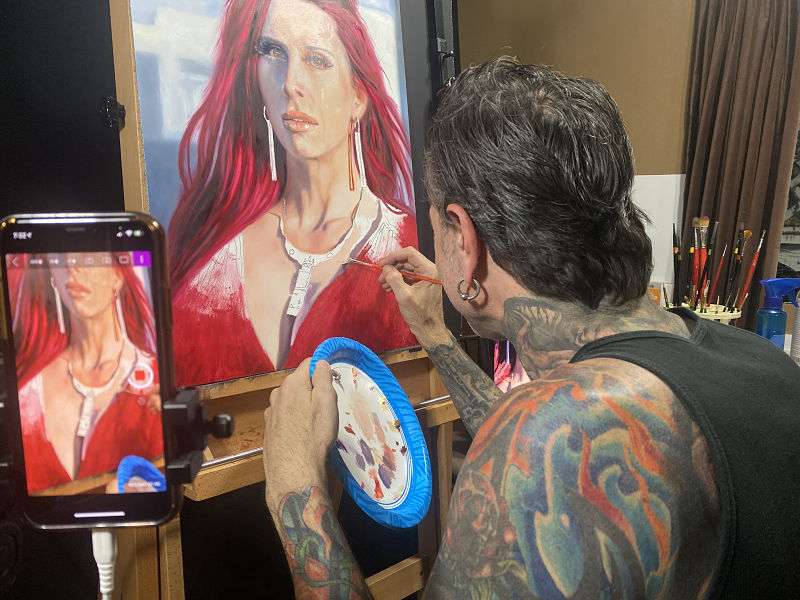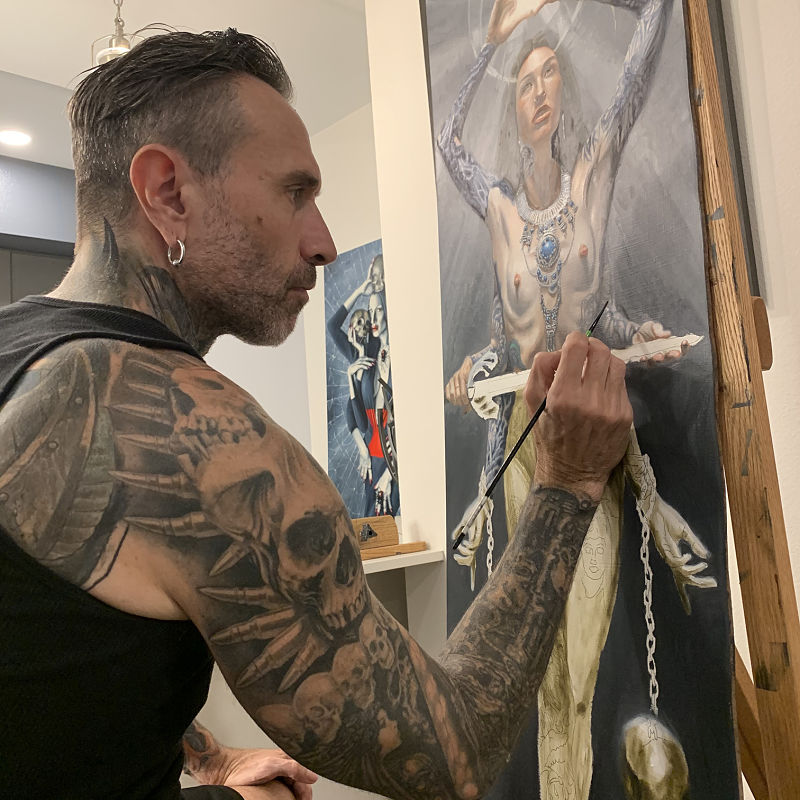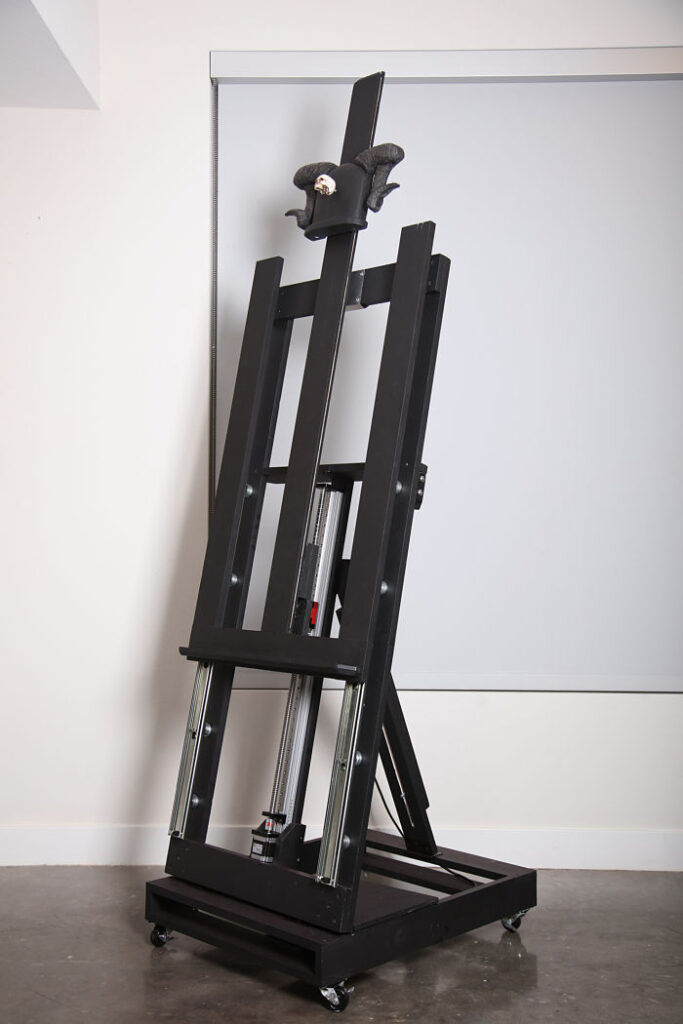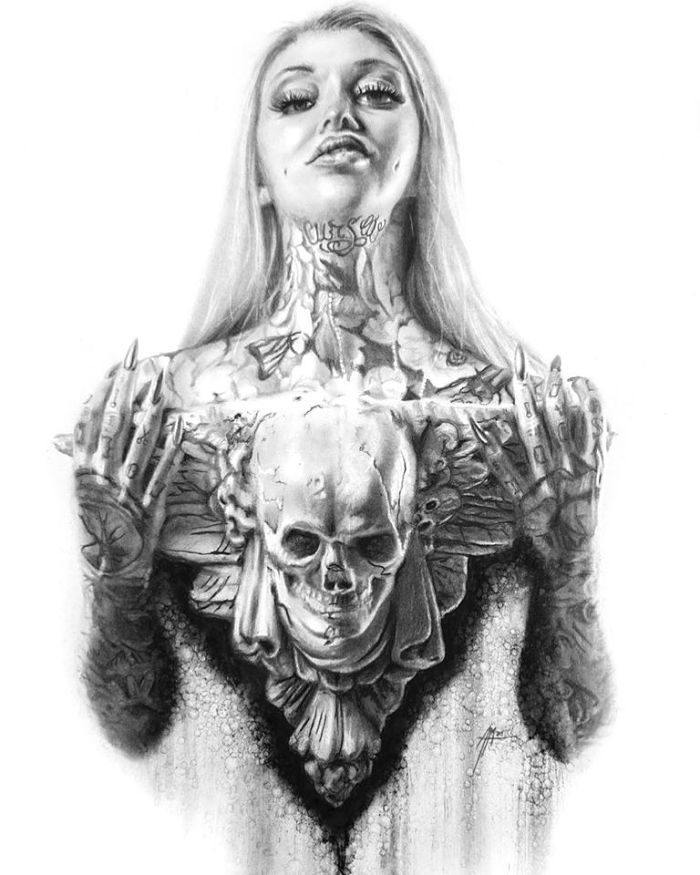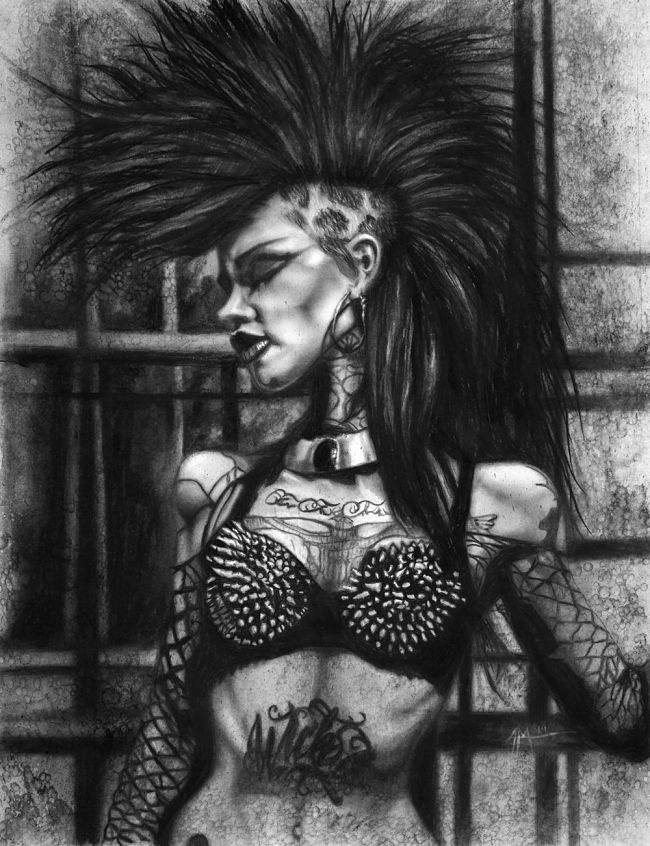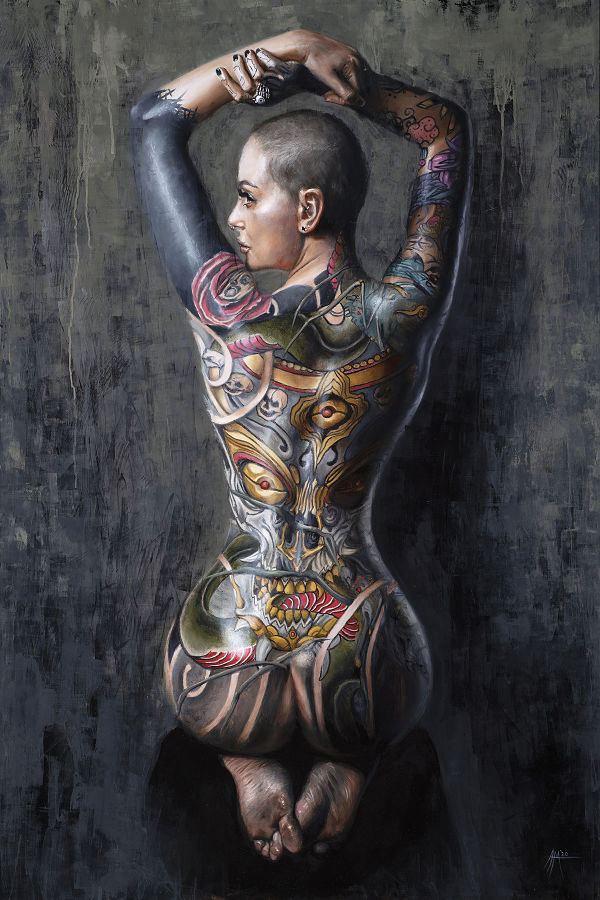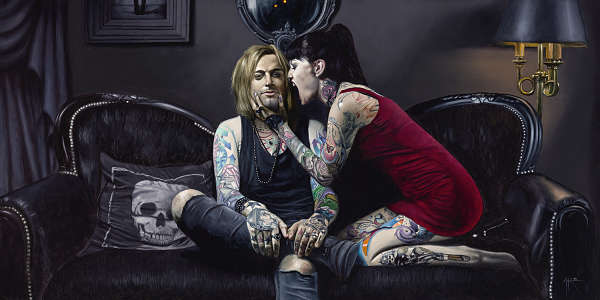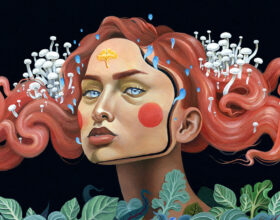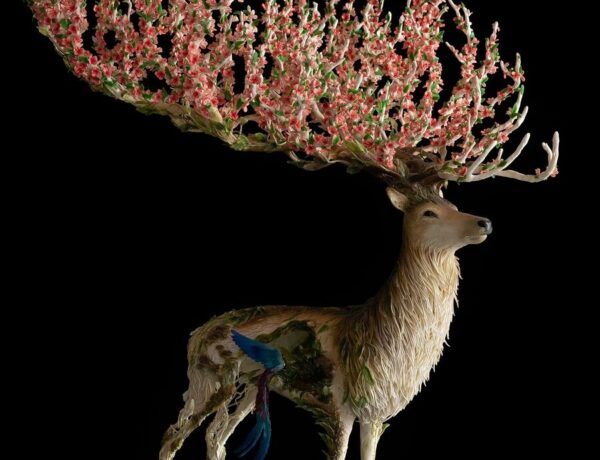Dangerous femme fatales, a scorned demoness, mistress vampires, and beautifully tantalizing narratives… Adam McCarthy’s affluence for penetrating portraiture and figurative work leaves viewers in a state of ensnared admiration and unease in equal measure. Casting nude forms across paper and canvas like a shadow in the night, the antithesis between elements renders a likeness as if a Victorian folklore and contemporary seduction rendezvoused in the disquieting darkness.
His intense figurative work heightens the characteristics of dramatic domination and tells a story of fantasy and darkness that welcomes its viewer’s curious mind to learn more. The result of Adam McCarthy’s tattoo laden vision is nothing short of spectacular. Take a moment and discover the provocative nuances of his work, thoughts on the artist’s role in today’s society, and what lies ahead on the uncharted horizon.
I’ve always been drawn to images with dark themes. I think that comes from man’s primal fear of death. As one matures, we learn to push back that fear in order to survive and embrace the inevitability of death. My desire to create images with macabre theming comes from a place of wanting to control fear as opposed to being overcome by it.
About the Artist // Adam McCarthy is a professional artist currently working in the video game industry as an Art Director. Though he is fulfilled by his work in the digital space, his passions lie in the use of his hands to create. The process of drawing and painting gave Adam the organic medium to complete him as an artist. Ever evolving and unbound by the restraints of a particular “theme”, Adam’s style consists of each creation being of new material and new technique. The only constant that can be found on his canvas is the dark narrative of his mind. In the relatively short time that he has spent in this craft, Adam has grown creatively so much that it leaves many anxious to see what comes next.
Exclusive Interview with Adam McCarthy
Adam, it’s wonderful to talk with you and gain further insight into the mysterious corridors of your creative mind. Thank you for taking time to share with our curious audience. The wildings of a feral protagonist emerge from thought to canvas, and your work seems to fuse elements of dark fantasy and eroticism alongside the harmonic complexities of the human condition. How do you fuse these diverse symbols and unconstrained themes so effortlessly?
Thank you so much for taking the time to speak with me!
I’ve always been drawn to images with dark themes. I think that comes from man’s primal fear of death. As one matures, we learn to push back that fear in order to survive and embrace the inevitability of death. My desire to create images with macabre theming comes from a place of wanting to control fear as opposed to being overcome by it. I also find great strength in the female form. The beauty and grace of a woman’s curves, married with images of strength and power is incredibly compelling to me. I’m haunted by visions of women in powerful poses that I become overwhelmed with a desire to create images celebrating that. For example, in my painting “Visceral II”, you see a woman’s body covered in blood… but she’s not wounded, she’s just covered in it, standing defiantly and gracefully. One wonders whose blood she’s covered in. I don’t stage the women in my paintings as victims, but rather more as deities with strength beyond mere mortal men.
Once I get my “idea”, I will sit with it, in my mind, and just nurture it. This comes from literally just sitting and thinking about the image. Manifesting it, and fleshing out the details of what I want the image to look like, all in my mind’s eye.
There is often a distinction between the creative process and the cerebral manifestation that accompanies it that works in a synergistic manner… like a needful companion at the helm of artistry. Will you share with us more about your artistic approach and process?
My process begins with an idea. It’s hard to really describe where my ideas come from, as they tend to just present themselves in my mind. Sometimes those ideas will come from nowhere, as if manifesting themselves into existence through me. And sometimes I get ideas that are sparked when I see a specific model, and something about her compels me to come up with a specific idea that would suit her look. While I am also inspired by ideas that I see from other artists, I try not to let the outside influences affect too much of my work. That said, a lot of times I’ll see a piece that inspires an idea, and I’ll take it into a different direction and make it my own. Sometimes that’s just by seeing a color scheme, or lighting setup that inspires me to incorporate something that I find compelling into my own work. Other times, it’s just a technique that I want to try to get some more variety in my rendering style.
Once I get my “idea”, I will sit with it, in my mind, and just nurture it. This comes from literally just sitting and thinking about the image. Manifesting it, and fleshing out the details of what I want the image to look like, all in my mind’s eye. I usually write down these ideas, and then come back to them at a later time to contemplate them further, until I have a crystal clear image in my head, and then I just deconstruct the image and figure out what it will take to bring that idea to fruition.
The next stage is to hire a model, and plan a photo shoot. At this point, I need to know what lighting, poses, and costuming I want. I paint a lot of nudes, so costuming is not my strong area, but that’s something I want to get into more in my future work. When I shoot with models, I usually have more than one concept in mind, as shooting is time consuming to set up and execute, so the more reference you get from one shoot, the more images I can create without having to go through that part of the process. I have absolutely fallen in love with photography, and working with models. More than a few times, the model has brought ideas of her own that I have ended up liking more than my original idea, and so I absolutely view this part of the process as a collaboration.
Once I have the photos, I do a fair amount of Photoshop work to work on the composition; add any additional elements that I want to enhance the image. How much time I spend in Photoshop depends on the piece. With some, I just want a loose idea and work out the rest on the canvas, and with other more complex images, I’ll spend more time getting every detail worked out before going to canvas. Once I’m happy with the image, I print it out and transfer the design to canvas using graphite paper. From there, I’ll do an underpainting layer with thinned oils to work out the value structure. I try to do this in one sitting, without going into too much detail. I just want to block out the composition’s general value structure. Once that layer is dry, I just get in there and start rendering until the piece is complete.
I was reading your bio and it says you are currently working in the video game industry as an Art Director. What can you share about that and how do balance work alongside exhibitions and your many personal projects?
Yeah, I’ve been working in video game development for over 26 years now. I got into it very young, and it’s been an amazing career that has supported me and my family for my entire adult life. Not only has it been a very fulfilling career, but it’s also kept me constantly surrounded by incredibly talented artists, from whom I have learned so much. I’ve always been fascinated by the marriage between technology and art, and so I got into 3D modeling and animation very early on, and have been able to work on some incredible projects. I’m currently Art Director on James Cameron’s Avatar: Pandora Rising, which is a mobile phone game based off of the films. We’re working directly with Lightstorm, Cameron’s production studio, and with some of their top production designer artists, so that has been a very rewarding experience. That said, one gets tired of sitting in front of a computer all day, and so within the last decade, I’ve really fallen in love with getting out of the digital space, and creating images with actual, real-world materials!
As far as the balance, well that can be difficult, and it just comes down to discipline. A long stressful day can be very tiring, so when my day is done, I have the option to either sit down and watch TV, or some other pointless activity, or I can pick up the brush and create something that will inspire people. I am totally addicted to creating images with oil paint, and so I just do my best to stay focused and always have projects in progress.
I’m fascinated by how much the tattoo community has grown, and how the quality level has reached just absolutely epic levels. The effects that tattoo artists are doing in flesh now is absolutely breathtaking, and as an oil painter, I absolutely love rendering tattooed flesh. The way the art curves around the human form, and the way that the light bounces off the skin, leaving a glowing sheen over the flesh.
Take us inside your art studio. I’m imagining this dark creative space, a brooding lair strewn with paint and brushes, skulls and velvet Edwardian style in equal chaos. Photography lamps burn in the corner as your horned black easel begs for your attention. Maybe your Drogoth pic, circa 2006 has my imagination under the influence so why don’t you describe it as it actually is. And tell us about that horned motorized easel your girlfriend crafted in surprise for you! If that’s not impressive, I don’t know what is.
Ha! I wish it was that romantic! No, I actually paint in my kitchen! And I wish I was joking, but it’s actually more like what would be the “dining area”, with my easel as opposed to a dining table. I have a pretty small house, and although my daughters are adults now, I still have a space for them when they stay with me, so I have my painting setup in my dining/living room area. I do my photography in my bedroom or in my small 1-car garage if I need a bit more space. The GOOD news is that I’m actually working with an Architect to design a brand new house! I’m tearing down my small 2-bedroom house, and building a new 4-bedroom 2-story home from scratch on the same property, and I’ve custom designed my own painting studio! Once that space is complete, I plan on creating a space much more akin to the description with which you started the question!
And YES, what an AMAZING gift that easel was! For your readers: My girlfriend is a mechanical engineer, specializing in control systems. She surprised me for my birthday last year by designing and building an automated easel, from scratch, with her own hands! The structure is made out of pine wood. It raises and lowers the canvas with push buttons by a stepper motor + bearing ball screw and linear glides. There are also rails on each side for support and so it stays square. She painted the whole thing black and added demon horns and a skull adjustment knob for the top canvas support. It’s absolutely incredible, and I’ve never been more blown away by a gift in my life, I am truly a lucky man! The new easel will be the crown jewel of my new studio once the house is complete!
As for the “Drogoth” pic you mentioned, that was a photo from my days as a Lead Singer in a Black Metal band called “Sothis”. My latest project is called “Witch Casket”, and I’m hoping to have some new music to release soon!
When I’m not creating art I’m usually looking at art, which I think makes me a more felicitous conduit for the influx of haunting visions. It then becomes my job to interpret them, deconstruct them, and create a process in which I can bring these images to fruition.
Honestly, what is it about tattoos in your work?
Well, if anyone has seen a photo of me, you’ll see that I’m pretty covered in tattoos. I’ve been collecting them for over 30 years now. I’m fascinated by how much the tattoo community has grown, and how the quality level has reached just absolutely epic levels. The effects that tattoo artists are doing in flesh now is absolutely breathtaking, and as an oil painter, I absolutely love rendering tattooed flesh. The way the art curves around the human form, and the way that the light bounces off the skin, leaving a glowing sheen over the flesh. I just find it fascinating, and I love the challenge of rendering the tattoos so that they look convincing and realistic!
Your realistic renderings loom with wandering souls, ceremonial ritual, and at times, blood soaked bodies reminiscent of the stigmata. Who are your subjects? Where do they come from? Are they tormented or fighting spirits?
I just seem to have an internal receptor for ethereal images! I wish I could more eloquently explain how I get my ideas, but they really do just come to me, like ethereal voices from the beyond. I tend to immerse myself in artistic influences. When I’m not creating art I’m usually looking at art, which I think makes me a more felicitous conduit for the influx of haunting visions. It then becomes my job to interpret them, deconstruct them, and create a process in which I can bring these images to fruition.
In the same vein, I believe in the emotional benefit of dreams, studying interpretation and the mysteries of lucid dreaming. Do you ever take inspiration from your dreams? If so did it impart in you a significant knowledge or feeling that later conceptualized a painting or drawing?
I can’t say that I remember ever specifically taking an image directly from a dream and recreating it. That said, I do feel that our dreams come from a place in the subconscious that is not easy to directly tap into. And since a lot of my ideas for paintings just sort of find their way into my thought process, I do feel as though the subconscious plays a huge part in influencing my creative process. Therefore, I think they do still come from a type of dream-state, where the creativity of my subconscious voice finds its way from the depths and into the light.
Which of your works do you feel contributes most significantly to your craft? Why does it speak louder than the others?
I feel that the painting “Kapala” (below- left) was a turning point for me as far as the quality of my work. As someone who has been painting tattooed skin for a long time, I feel that the time and attention to detail that I put into that piece really took a step forward as far as realistically rendering tattooed skin. The way that light enters the epidermis, and reacts to the ink pigment below that layer of flesh has a look that’s difficult to capture, and I feel as though I was more successful in rendering that effect than I had been previously. I have improved in the technique of blending the lines of the tattoo ink along with the flesh tones in a way that’s soft enough so that it doesn’t appear “drawn on” over the top of the skin, but not so blended that it becomes a blurry mess.
Some of my earlier attempts at this look have ended up looking a bit fake and “drawn on”, and I feel this piece was more of a success than earlier attempts. In addition to the tattoo painting effect, I’m also really happy with the way the face was rendered. I’d been trying different techniques, palettes, and brush types after learning some techniques in different workshops, and this particular piece ended up with a really cool amalgamation of those new techniques. There is a wide variety of hues in her flesh, and the brush strokes are captivating and flattering to the piece.
Art, regardless of form or era, shapes expression in ways that are unique and fluent to the individual artist. What role do you feel the artist has in today’s society? And where do you see yourself within that role?
I feel that the role of a “Traditional” artist in today’s society is to preserve the craft and process of creating art with actual, physical materials. The “artist”, before the invention of the camera, was the ONLY people that could tell a story with visual images. Centuries of study went into learning different techniques for producing images that people could use to tell a story. Year after year since the invention of the camera, there have been further technological advances to visual storytelling. From movies, to digital painting software, to 3D modeling and animation, and now even deep fake technology, which gives digital artists endless possibilities in creating storytelling images. These advances have systematically made traditional artwork “less important”. That’s not to say that traditional art doesn’t have a place in today’s society, it just means that it has more competition.
As for myself, I have a long career in creating digital artwork, and it has been extremely satisfying as an artist to be able to create with such powerful tools. But, it’s my connection to creating images with oil paints, charcoal, canvas, and paper that ground me to a more physical world, which helps me feel connected to the physical plane on which we exist. All that has to happen to the digital art world is for the power grid to go down. Boom. No more art! But drawings, paintings, sculptures…. they’re real. They’re here physically in front of you, to see, touch, and even smell! As much as I am proud of my long career in digital art creation, it is my physical work of which I am most proud.
2020, is at long last a thing of the past. But I dare say it will never be far from our thoughts. And while we can look back, we forge ahead. What are you looking forward to in the New Year? What can we hope to see from you?
The next year is very exciting for me, in that I am working towards a two-artist show in one of my favorite galleries: Copro Gallery in Santa Monica, CA. I have shown there many times before, but this will be my first large show with them. I will have several new works there, along with the unveiling of what I consider to be my most ambitious piece yet! It’s a large piece at 6 feet wide, 3 feet tall and featuring 10 figures in a narrative painting that I’ve been planning and working on for over 2 years! I’ll be sharing the space with Rachel Bridge, of whom I am a HUGE fan. I absolutely love Rachel’s work and I think her work compliments mine so well, and I think we are a perfect fit to show together. I’m very much looking forward to that! The show will run from May 29 to June 19 2021.


